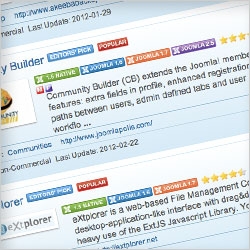Personal views (19)
Sometimes I experience things in my work with Joomla that lite that spark - and I just have to get it off my chest ;)
Joomla is a project that relies on volunteers. All the work being done on a daily basis in the project is based on the fact that thousands of people around the globe spends their time on Joomla. They code, test patches, report bugs, write documentation, market and promote Joomla to new and existing users, translate, plan and conduct events. These are only some of the many things that benefit us as a community and Joomla as a project. This is, in fact, the premise of an open-source community-driven project. Without the volunteers, Joomla would die. Simple as that.
2.5.3 is the current version of Joomla at the time of this writing. And as I wrote about last week, this latest version contains two important security fixes. Still, the small version badges (icons) showing supported Joomla versions are plastered across the Joomla Extensions Directory and developer's web sites.
The bad thing about showing these badges is that they give an impression that Joomla 1.6 and 1.7 are still supported versions. They are not. None of those versions are updated anymore, and they should not be used on any site.
But what about security updates, then? That's easy: Use version 2.5.3 (and later). That's the path to follow.
 A few weeks ago, I got a question from one of my readers regarding the ecommerce solution Ecwid and Joomla.
A few weeks ago, I got a question from one of my readers regarding the ecommerce solution Ecwid and Joomla.
The reader wanted to know if this web shop solution was a good one to use with a Joomla site.
To be honest, I hadn't heard about Ecwid before, so I decided to take a look.
 For years, people have been asking for real remote blogging support for Joomla.
For years, people have been asking for real remote blogging support for Joomla.
Remote blogging, or remote publishing, is when you use a desktop software package (Windows Live Writer) or plug-in (like ScribeFire for Firefox) to create and edit your posts.
When you're done, you add the post to the Joomla web site directly, without even logging in to the Joomla administrator.

When creating a Joomla site, it's incredibly easy to go overboard with extensions. The incredible selection of extensions and templates makes it tempting to implement too many and to spread your knowledge too wide.
As a Joomla integrator, I find it's crucial to find a method of implementing sites which makes it easy to set up, maintain and document a large number of sites. Moderation is a virtue, a least when building Joomla sites.
For instance, the use of too many CCKs, text editors or template frameworks will lead to constant headaches. Particularly in the documentation of a site, it's important to reuse information. If you're using too many extensions and different processes for each site, the task of documenting and training will be so much harder.
 Yesterday, David Risley published a guest post featuring an infographic. The theme of the infographic was the Most popular blogging platforms compared. The infographic features the most popular systems people use for blogging.
Yesterday, David Risley published a guest post featuring an infographic. The theme of the infographic was the Most popular blogging platforms compared. The infographic features the most popular systems people use for blogging.
The sad thing for me, was that Joomla isn't even on the list of blogging platforms mentioned in the infographic. As you know, I'm blogging about Joomla with Joomla. And I think it works great.
 Online, it's so easy to say something you would never say to another person's face. It's easy to throw out a lot of negativity, use foul language and don't care about the other person's reaction.
Online, it's so easy to say something you would never say to another person's face. It's easy to throw out a lot of negativity, use foul language and don't care about the other person's reaction.
Perhaps you should stop and think again before you write a negative comment on a blog, a harsh tweet or a ranting forum post. Would you say the things you say if the person was sitting across the table at a coffee shop? Would you be that harsh? Or would you let the other person have a chance to present his or her view and reasons for doing this or that? I think you would - but online it's so easy to forget these common-sense rules we try to live by in real life.
 Building a strong brand has a lot to do with being unique. And it's about positioning your brand so the audience knows who you are and what you stand for.
Building a strong brand has a lot to do with being unique. And it's about positioning your brand so the audience knows who you are and what you stand for.
There are many shoe manufacturers out there, but Nike stands out because they "just do it". Apple sets itself apart from other companies by being extremely innovative and actually creating new product segments (the iPod, the iPhone, the iPad - need I say more?). Apple used the slogan Think different for a number of years.
A Content Management System in itself is not anything unique. There are many CMS out there, and quite a few of them have a lot going for them. How do they set themselves apart from the crowd? What do their brands stand for? In this post, I take a look at how three other CMS present themselves and how Joomla compares.
 Joomla! has become quite a strong brand. The Joomla name is recognized in many parts of the world as a powerful CMS. Still, there are lots of people who have never heard about Joomla. As a community, we need to work hard to promote the Joomla brand. And to me, the Joomla brand is equal to its community. The power behind Joomla is not just the power of the software.
Joomla! has become quite a strong brand. The Joomla name is recognized in many parts of the world as a powerful CMS. Still, there are lots of people who have never heard about Joomla. As a community, we need to work hard to promote the Joomla brand. And to me, the Joomla brand is equal to its community. The power behind Joomla is not just the power of the software.
To me, the real power of Joomla is the community that drives it forward. That's you, that's me, that's everyone who contributes, uses or promotes Joomla in any way. And we all come together under the Joomla name.
Sometimes, however, people represent Joomla under a different name.
 For a number of Joomla sites I create, the editing requirements for the client are quite low. What I mean is - they don't need to edit much more than the content of the site. Entering new and editing existing articles.
For a number of Joomla sites I create, the editing requirements for the client are quite low. What I mean is - they don't need to edit much more than the content of the site. Entering new and editing existing articles.
Sometimes, the computer knowledge of the user is quite limited. In these cases, I want the editing to be as easy as possible as possible. That's why I use the front-end editing capabilities of core Joomla, K2 and FlexiContent. Depending on which system I'm using for that particular site.
Front-end editing has an obvious advantage: The user knows exactly where she is in the system. She clicks to a page, sees something to edit, logs in and clicks edit. When logged in, she might also need a menu showing a link to add a new article and other links only visible to editors.
So, I want the front-end to be as intuitive as possible.
The other day, I realized how few Joomla template designers actually do something fresh and innovative in this respect. I think there is an opportunity to differentiate by improving how the editing mode of the site is presented. This is something I believe can be improved quite easily if the template designer cares about it.
 Whenever I test a new extension, one of the first things I test is validation. Using the W3C validation service I can check if the extension outputs validating code.
Whenever I test a new extension, one of the first things I test is validation. Using the W3C validation service I can check if the extension outputs validating code.
The Markup Validation Service is a validator by the World Wide Web Consortium (W3C) that allows Internet users to check HTML documents for conformance to HTML or XHTML standards. It also provides a quick method for web page authors to check their posted pages for mark-up errors.
Running your site through a check like this is valuable and and easy way to check if you have made any mistake in your coding.
And, as I mentioned, it is a really good way of knowing if the brand new extensions you installed in your Joomla site will produce validation errors on your page.
 In February of 2010 I went back to working full time with my own business. It was a relief, and something I had thought about for a long time.
In February of 2010 I went back to working full time with my own business. It was a relief, and something I had thought about for a long time.
I started my business in 2001. At that time, my company evolved around creating web sites for smaller companies. This is my story.


